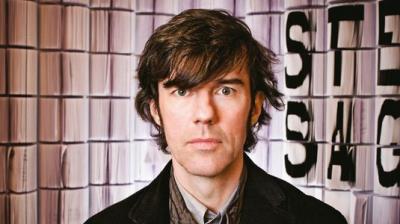Interview with award-winning designer Stefan Sagmeister

ROME- Award-winning graphic designer Stefan Sagmeister, famed for his work with the Rolling Stones, Lou Reed and Aerosmith, talked about happiness, travel and his stay in the Eternal City.
Born in 1962, Sagmeister, carved out his name designing graphics and branding for clients including HBO, Time Warner and the Guggenheim Museum, his notable works including the album cover Set the Twilight Reeling for Lou Reed and winning a Grammy in 2005 for the design of a box set of works by 1980s indie giants Talking Heads.
Sagmeister stopped off in Rome to visit the Rome University of Fine Arts and choose and present the winner of the RUFA (Rome University of Fine Arts) Contest 2015, after having personally chosen a task for the students: to choose something that they had learned so far in their lives, and to make a project about it. We went to meet the graphic designer at the Teatro Olimpico stadium, where the night was hosted.
After talking about the Contest, we asked Sagmeister about the struggles an artist/designer can face, having met so many new up and coming designers, and whether practical economic thinking is needed to fulfil one’s artistic potential.
“I believe that surely one reason why we in our studio have increasing influence on what we do, and thatt is that we are standing on very safe economic grounds. There are many, especially very young designers, who say “I do not care about money; it's all about me making beautiful works." I find this attitude, of course, very charming, but I always warn these designers that they can not say, that money does not matter.”
He added that “if I do not know where the next rent comes from, then it is very hard for me to do a really good job. The rent must be already covered before I can think of self-fulfilment”.
Turning more towards his work, we commented upon the large amount of nudity in his work, and questioned why it featured so prominently.
After commenting that there was a large contrast between the handling of nudity in Austria, and New York (where it is much more unusual in the context of design, perhaps more of a taboo), he continued by saying, “when I as a designer have the audience’s attention only for a very short time, I like to use the unusual.”
As such he also always used male nudity in his work, as it is more unusual, “not that I do not like beautiful naked women, but I do not like beautiful naked women in the field of advertising and design, because they have been used there very often.”
Then, we turned the interview away from his work, and more towards the personal, his personal philosophies and his ideals on happiness.
Sagmeister shared with his audience, at the Teatro Olimpico, his philosophy that it was not important that the audience had come to see him, but rather they were doing something that they hadn’t done yesterday and that they wouldn’t do tomorrow. That is, the importance of doing something new everyday.
So, when we asked him what he considered a waste of time, his answer very much chimed in with his aforementioned ideal:
“I would probably see it as a waste of time to do something that I had already done, and that turned out to be mediocre.”
When asked how it was best to express oneself, he replied “be honest.”
Sagmeister, had come all the way from New York to take part in this contest, so we asked the question: What does travelling mean to you?
“I travel a lot. I spend about half my time travelling. This interrupts my life in a wonderful way” he remarked.
“It often happens that when I sit down in the hotel room for an hour to think that there is something better coming out than when I would sit longer in the studio at home.”
Sagmeister also spoke about happiness in his speech, and so we asked him the fundamental yet difficult question: Are you happy?
“Yes, I would say so. I have very good happiness ratings, currently 7.8 out of 10.”
Sagmeister has no children, and when asked whether there is a connection between happiness and children, he responded:
“Yes, in very complicated way, I can now personally talk about it, because all my brothers and sister have children. When I look at the science, though, I have to look at it from both sides. On the one hand there is a very large, neat study by a US-scientist, Mihaly Csikszentmihalyi, who said that when he asked women what they're doing now and just how happy they are, educating children only comes on number 16, right before cleaning the toilet and far after watching television. When the same mothers are later asked what was the best thing they have done in their life, the children are always number one.
That is, in remembered happiness the children are number one, in the current happiness they are not. There is another Nobel Prize winner, who shows that happinesses are quite different. The happiness of remembering has much more to do with Meaning, and is therefore quite different than the experienced of current happiness.”
Sagmeister, currently creating a Happy Movie, told the Insider that it is practically finished.


